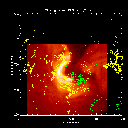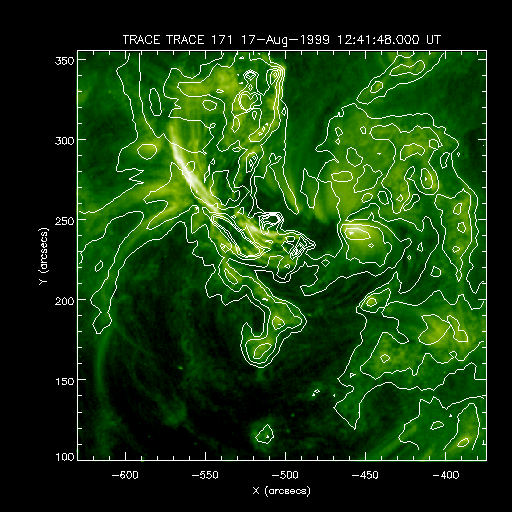WSM3 FLARE TOPOLOGY WORKING GROUP
CONTENTS
PREPARATIONS
Goals & Approach
Flare List
Overview of the sigmoid region (AR8668),
its evolution, flaring
Advance Data Preparations
Quick Look Movies
Tentative FTWG agenda
FTWG
Participants -- Role and Responsibility
REPORT FROM THE WORKSHOP
Report from
the Workshop
Plans for after
the Workshop
CO-ALIGNED DATA MOVIES
Co-Aligned
Data Movies
GOALS & APPROACH
In this WSM3 working group our goal will be to learn something
about the topology of the magnetic field of the sigmoid in AR 8668 through
observations of flares that occurred in this active region. The working
assumptions here are that:
-
flare energy release occurs along large-scale topological
features, e.g. separatrices or a separator, and we can therefore learn
about the toplogy of the sigmoidal structure by studying flares.
-
after overlaying images in various energy bands on magnetograms,
we can learn about the topology of the sigmoid by comparing these images
with the topological model.
We will co-align digital flare images and magnetograms obtained
before and during the Max
Millennium observing campaign MM002:
Eruptive Flares Associated with Sigmoids during WSM3 and compare them
to inferences from the topological model of Titov and Demoulin, A&A
351, 707 (1999)
(gzipped
PostScript file)
(top)
OVERVIEW OF THE SIGMOID REGION (AR8668),
EVOLUTION, FLARING
We will study AR8668 flares observed only on 16-Aug and 17-Aug
(the period during which several flares occured, yet the region is not
too close to the limb). An overview of these two days comes from
Sam Freeland's SXT
movies and Barbara Thompson's EIT
movies
FLARE LIST
Only 6 flares of GOES B class and above occurred in AR 8668
on August 16th and 17th:
Date DOY
Start End Max
990816 228
0018 0048 0034 N19E50SF
C 1.3 GOES 2.1E-03 8668
990816 228
1637 1653 1642 N24E47SF
B 8.1 GOES 6.8E-04 8668(see David Alexander's web
page)
990816 228
2023 2035 2029 N24E40SF
C 1.2 GOES 7.7E-04 8668
990817 229
0318 0347 0334 N23E42SF
B 9.5 GOES 1.4E-03 8668 (see Kuniko Hori's web
page or second web
page)
990817 229
1232 1357 1323 N26E35SF
C 2.6 GOES 1.1E-02 8668 (see David Alexander's
web
pag)
990817 229
1428 1754 1602
C 5.9 GOES 5.2E-02 8668 (see Narkiaki Nitta's Nugget.)
The second, fifth and sixth flares on this list are best
observed, and should be given priority if there is not time to study all
six of the events. Further details of which observatories have observations
of which flares, and "Context Data" such as magnetograms, is listed in
my table FLARES
IN NOAA AR 8668 DURING MMOC002 "SIGMOIDS" CAMPAIGN.
(top)
ADVANCE DATA PREPARATIONS
Please prepare your digital data in FITS format following
the guidelines given on the web page
SSW
FITS Keywords Standards. Once you have done that, it will be straightforward
to overlay your data with those of other observatories using Dominic Zarro's
mapping software. If, for some reason, you can't get your data in
FITS format with the right keywords, you must identify UT date and time,
image coordinates of solar disk center, image pixel angular size, and image
orientation to enough accuracy to be able to align the image to a few arc
seconds.
To get your data to Goddard, use the following procedure:
ftp orpheus.nascom.nasa.gov
login: guest
passwd: Workshop
This will take you to a 'pub' directory. Use
'mkdir' to create a directory
using your last name (e.g. 'mkdir zarro'). Move to that
directory
(e.g. 'cd zarro') and 'mput' your files.
Some tips:
(1) Don't forget to set 'binary' for binary file copies.
(2) Use FITS files for easy IDL reading
(3) Send GIF or JPEG files for Web display at the workshop
(4) Create subdirectories within your user directory
to organize different
file or data types.
To see the current contents of the directory at Goddard using
a web browser, use http://orpheus.nascom.nasa.gov/wsm
(top)
QUICK LOOK MOVIES
Before we can start to overlay flare images on magnetograms,
we need to have some quick-look movies in order to decide which times are
most interesting. Presumably we will want to overlay images early
in the flares, but there will be other constraints, as well, so we really
need to look at movies of each flare from each instrument to make a decision.
I therefore request that everybody who is contributing
data prepare one or more simple MPEG movies of their data to show everybody
in a quick way what observations they have, which can readily be run without
significant setup time. For each flare, the appropriate time frame
of such a moviemight be from about 20 minutes before the GOES start time
until the GOES end time. For some datasets (e.g. SXT full-disk),
it might make more sense to make a continuous movie covering at least two
days, perhaps more if needed by other working groups. Please ftp
these movies to Goddard, in the directory discussed in the paragraph above.
It may also be OK to use quicktime movies, rather than
MPEG -- that is still to be determined.
Let's plan to use the first day of the meeting to show
such movies.
(top)
TENTATIVE FTWG AGENDA
Wednesday Jan 19
Plenary WSM3 presentations -- see WSM3
3rd announcement
Quick Survey of the Observations
SXT - Hudson
NoRH - Hudson
EIT - Thompson
BBSO - Qiu
HASTA - Canfield
Interball - Canfield
MLSO - Canfield
MDI - Gregory
TRACE - Myers
Mees - Canfield
Thursday Jan 20
Do preliminary co-registration of each flare
on the list above
Friday Jan 21
Try to intrerpret preliminary co-registrations
in terms of Titov and Demoulin model
Decide what is worth doing with more care.
(top)
FTWG
PARTICIPANTS - ROLE AND RESPONSIBILITY
Alexander, David (alexander@lmsal.com)
-- SXT and TRACE observations
Bagala*, Gabriela (gbagala@cds.plasma.mpe-garching.mpg.de)
-- HASTA observations
Burkepile*, Joan (iguana@ucar.edu)
-- MLSO observations
Canfield, Dick (canfield@physics.montana.edu)
-- FTWG organization, interpretation of the Titov and Demoulin paper
Gregory, Sarah (gregory@mdisas.nascom.nasa.gov)
-- MDI observations
Hori*, Kuniko (hori@nro.nao.ac.jp)
-- NoRH observations -- see web
page
Hudson, Hugh (hudson@isass0.solar.isas.ac.jp)
-- SXT observations
LaBonte*, Barry (labonte@maile.ifa.hawaii.edu)
-- Mees observations
Liu, Yang (yliu@solar.stanford.edu)
-- MDI movie
Mikic, Zoran (mikic@iris023.saic.com)
-- Analysis of vector magnetograms
Myers, Dawn (dcm@chippewa.nascom.nasa.gov)
-- TRACE observations
Nitta, Nariaki (nitta@sag.lmsal.com)
-- co-registered observations of C5.9 flare and associated CME --
see Nugget
Qiu, Jiong (qiuj@bbso.njit.edu)
-- BBSO observations
Siarkowski*, Marek (ms@cbk.pan.wroc.pl)
-- Interball RF15-I X-ray observations
Thompson, Barbara (thompson@eitv3.nascom.nasa.gov)
-- EIT observations
Zarro, Dominic (zarro@orpheus.nascom.nasa.gov)
-- SOON observations, data organization at Goddard, co-alignment software
This is an updated list of those who participated at the
workshop.
(top)
REPORT FROM THE WORKSHOP
Various images and movies, and analyses thereof, are available:
On reviewing the movies, bearing in mind comparison
with models, we decided to overlay all available images at one time during
each of two flares on August 17th, as follows:
990817 229
1232 1357 1323 N26E35SF
C 2.6 GOES 1.1E-02 8668
| SXT |
TRACE |
EIT |
MDI |
SOON |
HASTA |
| 12:41:25 |
12:41:48 |
12:47:59 |
12:41:02 |
12:41:50 |
12:39:34 |
990817 229
1428 1754 1602
C 5.9 GOES 5.2E-02 8668
| TRACE |
EIT |
MDI |
SOON |
BBSO |
MLSO |
HASTA |
| 14:53:53 |
14:47:28 |
15:01 |
14:55:20 |
14:55:30 |
16:38:40 |
14:46:08 |
We had time to make the following two overlays using
Dominic Zarro's map software:

|
SXT-MDI
co-alignment
This overlay of MDI line of sight magnetic field contours on an SXT image
was relatively straightforward once the datasets were in FITS format, since
both datasets contain the necessary header information, with the necessary
accuracy, to make the maps used for the overlays. |

|
EIT-TRACE
co-alignment
This overlay of a TRACE flare image on EIT contours demonstrates the ability
to take a partial-sun field of view and co-register it with a full disk
image. This is important, since the solar coordinates of the TRACE image
are not well enough known, whereas those of EIT are. |
(top)
PLANS FOR AFTER
THE WORKSHOP
The basic decision was to make co-aligned movies, rather
than simply co-aligned images at certain times. Each instrument's
movie will be at that instrument's own cadence, co-aligned witth respect
to co-temporal contours from MDI (which has images very frequently, one
per minute), whose pixel coordinates in arc-seconds relative to Sun center
are very accurately known. Let's start by doing the three flares
listed in bold font in the table below. -- maybe that will be enough. Optimum
start and end times for the movies are given in red:
Movie Movie
GOES GOES GOES
Date
DOY Start End
Start End Max
990816 228 0000
0050
0018 0048 0034 N19E50SF
C 1.3 GOES 2.1E-03 8668
990816 228 1620
1655
1637 1653 1642 N24E47SF
B 8.1 GOES 6.8E-04 8668
990816 228 2000
2040
2023 2035 2029 N24E40SF
C 1.2 GOES 7.7E-04 8668
990817 229 0300
0400
0318 0347 0334 N23E42SF
B 9.5 GOES 1.4E-03 8668
990817 229 1200
1400
1232 1357 1323 N26E35SF
C 2.6 GOES 1.1E-02 8668
990817 229 1400
1800 1428
1754 1602
C 5.9 GOES 5.2E-02 8668
-
Bring SOON H-alpha images onto the solar disk coordinate grid using
BBSO and HASTA full disk images (Nitta, Qiu, Bagala)
-
Bring SXT, TRACE, EIT and MDI images onto the solar disk coordinate
grid as necessary (Nitta, Myers, Thompson, Gregory)
-
Make movies of TRACE, SXT, EIT, H-alpha overlaid on MDI contours
(Zarro)
-
Make timeline of what was observed in EIT for comparison with BBSO (Thompson)
-
Overlay Mees IVM vector magnetograms and current maps onto MDI magnetograms
(LaBonte)
(top)
CO-ALIGNED DATA MOVIES
Co-aligned data movies are now being produced. The
current ones are available on Dominic Zarro's Co-aligned
Data Movies page.
(top)



